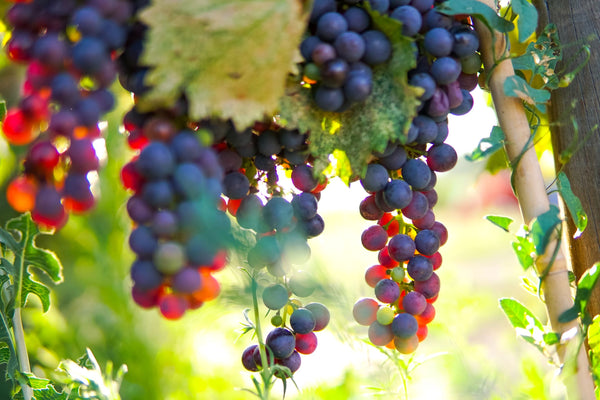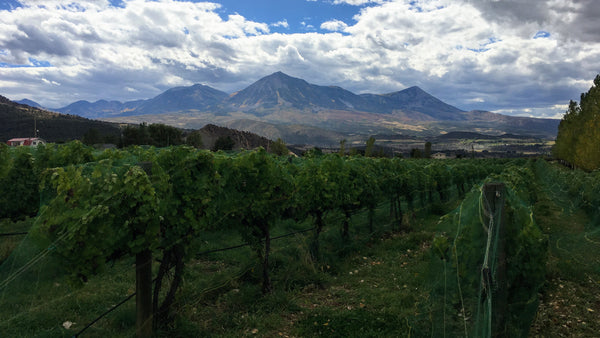Colorado's Key Wine Grapes
Growing wine grapes in Colorado is a tricky endeavor for any Western Slope farmer. Because of dramatic elevations, canyons and soil switching every time the Colorado River takes a turn, it's hard to peg the land suitable for just a few grapes.
One grower might find Bordeaux-style grapes fits his or her plot best. Another might notice that Rhone Valley fruit thrives just a mile away, around a river bend. Luckily, as a Front Range winemaker, we get to source from just about any grape grower in the state, allowing us to make a variety of different wines in a
ny given year.
These are our favorites:
Reds:
Cabernet Franc: This grape is often mentioned in the same sentence as the wine that could set Colorado apart from the rest of the winemaking world. It’s the parent of Cabernet Sauvignon, but has a slightly earthier and spicier makeup. On its own, this wine is perfect for typical California Cab drinkers looking for a break from monotony. Cabernet Franc also has a shorter growing season than Cab Sauv, meaning it hits full ripeness in most years.
Syrah (the same thing as Shiraz): Syrah has been around the Rhone Valley and Europe for centuries, but Americans know it best of its applications in South American and Australia. Colorado’s versions tend to fall somewhere between the strong fruit flavors of Argentina and the subtle earthy nuances of France.
Cabernet Sauvignon: While this may be California’s grape of choice, it also holds up pretty well in Colorado. Don’t compare it to Napa though. Colorado’s Cabs offer a nice mix of juicy fruit from California and food-friendly characteristics of Bordeaux, making for a wine that can be served with dinner and enjoyed alone on the porch.
Merlot: If it weren’t for Sideways, this might have already become Colorado’s champion grape. It’s a common grape in the world that does some interesting things in Colorado’s arid, desert soil. Merlots here hits a jammier note than most other regions because of the high day-time temperatures in the Grand Valley.
More reds to watch out for: Petit Verdot, Petit Sirah, Lemberger, Malbec and Pinot Noir. Plus: We love Zin, but it just doesn’t ripen in Colorado. So in most years we call our friends in Amador County to ship over a few tons to make our winemaker Paul happy — either in the form of a still wine or a Port-style dessert offering. He loves Zin!
Whites:
Sauvignon Blanc: This is one of the most versatile grapes in the world when it comes to flavor profiles, spanning everything from tropical to earthy tastes. In Colorado, it offers fun floral flavors that serve, in many years, as the base of Bella Risa.
Pinot Grigio: An often spicy and medium-bodied grape, Pinot Grigio has become a favorite at Bonacquisti recently. It’s the base for the 2010 Bella Risa (although we didn’t get it from Colorado this year). In future vintages, we plan on finding more Colorado Pinot Grigio instead of sourcing it from the West Coast.
Riesling: The classic German grape from Rhine and Mosel is another grape that, like Cabernet Franc, often gets pegged as one that can put Colorado on the map. But our climate is nothing like Germany or Austria, meaning Rieslings here are a hoot. The acids are a little lower (making them easier to drink on their own) and it is mostly produced in an off-dry manner, meaning there’s just a little residual sugar left in the wine.
Gewurztraminer: This is another classic German varietal that thrives here. We are planning on making our first version of it in 2011, producing a complex, just a tad sweet white that wins with a pungent floral nose.
Other whites we're making in Colorado: Chardonnay, the Muscat family, Viognier and Semillon.
Join our wine club to make sure you never miss a new wine offering!




1 comment
Along the front range I have a notion to try Tannat southeast of Pueblo or Walsenburg below 5,500 ft. There is some land there typically more likely cattle ranched. The challenge would be irrigation by well pump for the first four or five years. Tannat seems to have done well in Uruguay about the same altitude. I just worry about the wind and Coyotes.
Best Regards
Andrew Kottenstette